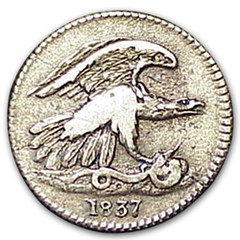
PREV ARTICLE
NEXT ARTICLE
FULL ISSUE
PREV FULL ISSUE
POSSIBLE ATTRIBUTION FOR THE FEUCHTWANGER R. E. RUSSELL TOKEN
Aaron Packard may have made a breakthrough in attributing the enigmatic Feuchtwanger-style R.E. Russell storecard. Here is an excerpt from an article he posted to his web site this week. Be sure to read the complete version online.
-Editor


Speculation has long existed that the R.E. Russell storecard featuring Feuchtwanger’s Obverse-6 die was struck for a New York City based merchant or business. Russell Rulau in his token guides has asserted this, and many other exonumismatists have naturally assumed that because the token features Feuchtwanger’s eagle, it was prepared for a New York merchant. Cataloged as HT-309, the token was struck in German Silver and features Lewis Feuchtwanger’s Obverse-6 design. The emission deviates from Feuchtwanger’s usual one-cent storecard in that its denomination was 12½ cents. Additionally, instead of Feuchtwanger’s usual reverse, engraved atop the emission is the name ‘R.E. Russell.’ Assumed to be name of an issuing merchant, it features the acronym ‘I O U.’ Presumably, it means “I owe you.” Despite the historical assumption that R.E. Russell was a New York City merchant, anyone who has taken even a cursory moment to research the origins of the storecard has quickly found that associating a New York City merchant with the token is impossible. None of the contemporary New York City directories list an R.E. Russell. Other numismatists including David Bowers have conducted exhaustive research on many of the Feuchtwanger emissions. In his More Adventures with Rare Coins the token is briefly mentioned, but no issuing merchant is identified. Later, during direct correspondence with Bowers, he confirmed that thus far numismatists have been unsuccessful at attributing any merchant with the token. Previous die analysis incontrovertibly connects the firm of Bale and associates with the Feuchtwanger emissions. The same firm has also been connected with Richmond’s Beck’s Public Baths token. Moreover, die analysis also connects the R.L. Baker storecard to Bale and associates similarly. These connections affirm the great geographical reach that the private mint had. Based on these earlier findings by others, the author had to consider the possibility that the R.E. Russell token may have been struck for a merchant far away from New York City. Expanding his search to include the entire United States, via libraries, newspaper archives, and other historical sources from outside the New York City area, there was but only one merchant found that used R.E. Russell moniker around 1837. That merchant was Robert E. Russell of Columbia, South Carolina. It has yet to been determined incontrovertibly if Robert E. Russell of Columbia, South Carolina was the same R.E. Russell on the storecard. However, it highly probable that they are indeed one and the same. Both the man and the token used the same “R.E. Russell” moniker. Both the man and token were contemporaries. Indeed, what appears to remain uncertain is whether the storecard was issued for his seed business, his public baths, as an admission token, or his boarding house. Of the prolific number of R.E. Russell advertisements uncovered and viewed, none encountered thus far allude explicitly to a token. However, two different possibilities exist that infer pricing plausibly associated with the token. The first possibility suggests it could have been an admission token to his Botanical Garden.

A second possibility suggests a connection to his advertisements placed in the summer of 1840. Although no explicit pricing relates specifically to 12½, the advertisements allude to pricing based on bits. His advertised cost for a cold bath was set at 2-bits, while the advertised cost for a warm bath was set at 3-bits. Since 12½ cents equals a bit, two or three of the R.E. Russell HT-309 tokens could purchase a bath.

Further research into the final affirmation of Robert E. Russell of Columbia South Carolina and the R.E. Russell storecard is both warranted and will progress. To read the complete article, see: THE CURIOUS R. E. RUSSELL TOKEN DECRYPTED? (www.novanumismatics.com/engraving/the-curious-r-e-russell-token-decrypted/)
THE BOOK BAZARREWayne Homren, Editor The Numismatic Bibliomania Society is a non-profit organization promoting numismatic literature. See our web site at coinbooks.org. To submit items for publication in The E-Sylum, write to the Editor at this address: whomren@gmail.com To subscribe go to: https://my.binhost.com/lists/listinfo/esylum All Rights Reserved. NBS Home Page Contact the NBS webmaster 
|